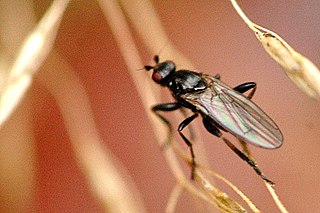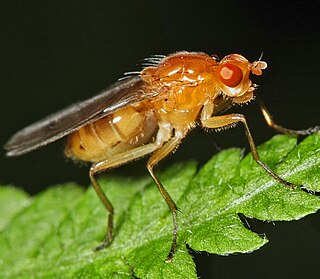
Leander (Franz) Czerny was an Austrian entomologist and priest. He was mainly interested in Diptera.

Sphaeroceridae are a family of true flies in the order Diptera, often called small dung flies, lesser dung flies or lesser corpse flies due to their saprophagous habits. They belong to the typical fly suborder Brachycera as can be seen by their short antennae, and more precisely they are members of the section Schizophora. There are over 1,300 species and about 125 genera accepted as valid today, but new taxa are still being described.
The Nymphomyiidae are a family of tiny (2 mm) slender, delicate flies (Diptera). Larvae are found among aquatic mosses in small, rapid streams in northern regions of the world, including northeastern North America, Japan, the Himalayas, and eastern Russia. Around a dozen extant species are known, with two fossil species found in amber, extending back to the Mid Cretaceous. Under an alternative classification, they are considered the only living representatives of a separate, suborder called Archidiptera which includes several Triassic fossil members. The family has characteristics associated with the Nematocera as well as the Brachycera. The antennae are shortened as in the Brachycera and these flies are long, having a snout with vestigeal mouthparts, non-differentiated abdominal segments with large cerci. The wings are narrow and hair-fringed and have very weak venation. They are known to form cloud-like swarms in summer and the short-lived non-feeding adults have wings that fracture at the base shortly after mating.

The Heleomyzidae is a small family of true flies in the insect order Diptera. Over 740 described species of Heleomyzidae occur in about 76 genera distributed throughout the world.

The Micropezidae are a moderate-sized family of acalyptrate muscoid flies in the insect order Diptera, comprising about 500 species in about 50 genera and five subfamilies worldwide,. They are most diverse in tropical and subtropical habitats, especially in the Neotropical Region.

Dolichopodidae, the long-legged flies, are a large, cosmopolitan family of true flies with more than 8,000 described species in about 250 genera. The genus Dolichopus is the most speciose, with some 600 species.

The Lauxaniidae are a family of acalyptrate flies. They generally are small flies with large compound eyes that often are brightly coloured in life, sometimes with characteristic horizontal stripes, such as in Cestrotus species. Many species have variegated patterns on their wings, but in contrast they generally do not have variegated bodies, except for genera such as Cestrotus, whose camouflage mimics lichens or the texture of granitic rocks.

The Lonchaeidae are a family of acalyptrate flies commonly known as lance flies. 610 described species are placed into 10 genera. These are generally small but robustly built flies with blue-black or metallic bodies. They are found, most commonly in wooded areas, throughout the world with the exception of polar regions and New Zealand. Details of the distribution of genera and species by biogeographic realm are included in the World Catalogue of the family Lonchaeidae

The Chamaemyiidae are a small family of acalyptrate flies with less than 200 species described worldwide. The larvae of these small flies are active and predatory and are often used for biological control of aphids, scale insects, and similar pests. Chamaemyiid fossils are poorly represented in amber deposits, but a few examples are known from the Eocene epoch onwards.

Opomyzidae is a family of acalyptrate Diptera. They are generally small, slender, yellow, brown or black coloured flies. The larval food plants are grasses, including cereal crops, the adults are mainly found in open habitats. Some species being agricultural pests.

Odiniidae is a small family of flies. There are only 58 described species but there are representatives in all the major biogeographic realms.

The Dryomyzidae are a small family of flies ranging from 4–18 mm long, with prominent bristles, and yellow to brown or rust-yellow coloring. The wings are very large. The subcosta is complete and well separated from vein 1. Larvae feed on decaying organic matter - carrion, dung, and fungi. The prelambrum protrudes from the oral cavity. Vibrissae are absent and the postvertical bristles are divergent.

Clusiidae or "druid flies" is a family of small, thin, yellow to black acalyptrate flies with a characteristic antenna and with the wing usually partially infuscated. They have a cylindrical body. The head is round, the vertical plate reaches the anterior margin of the frons and the vibrissae on the head are large. The costa is interrupted near subcosta and the latter developed throughout length. Larvae are found in the bark of trees, the flies on trunks. The larvae are notable for their ability to jump. Males of many species in the subfamily Clusiodinae have been observed while engaged in lekking behaviour. There are hundreds of species in 14 genera found in all the Ecoregions, although most species occur in tropical regions. The type genus is Clusia Haliday, 1838.
Anagnota is a genus of flies of the family Anthomyzidae. Currently there are four described species that occur in the Palaearctic region:

Tethininae, formally the family Tethinidae is a paraphyletic group of tiny drab-coloured or grey Acalyptratae flies. There are over 115 species in 7 genera known from all zoogeographic regions. They are inconspicuous flies which are still poorly known in some remote, huge, tropical areas.

Limosininae is a subfamily of flies belonging to the family Sphaeroceridae, the lesser dung flies.

Spelobia baezi is a species of fly belonging to the family of the Lesser Dung flies.
Stenomicridae is a family of flies belonging to the order Diptera. Flies in this family are yellow in color and easily mistake for Cecidomyiidae. The family is found in Europe.

Zealantha thorpei is a species of fly belonging to the family Anthomyzidae. First described by Jindřich Roháček in 2007, it is endemic to New Zealand and currently the only known member of Anthomyzidae found in the country.

Zealantha is a genus of fly belonging to the family Anthomyzidae. The genus was described by Czech entomologist Jindřich Roháček in 2007.



















